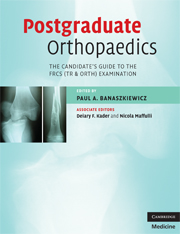Book contents
- Frontmatter
- Contents
- List of contributors
- Foreword by Mr Peter Gibson
- Preface
- Glossary
- Section 1 The FRCS (Tr & Orth) examination
- Section 2 The written paper
- Section 3 The clininicals
- Section 4 Adult elective orthopaedics oral
- 14 General oral guidance
- 15 Shoulder and elbow oral core topics
- 16 Hip oral core topics
- 17 Knee oral core topics
- 18 Foot and ankle oral core topics
- 19 Spine oral core topics
- Section 5 The hand oral
- Section 6 The paediatric oral
- Section 7 The trauma oral
- Section 8 The basic science oral
- Section 9 Miscellaneous topics
- Index
- References
18 - Foot and ankle oral core topics
from Section 4 - Adult elective orthopaedics oral
Published online by Cambridge University Press: 22 August 2009
- Frontmatter
- Contents
- List of contributors
- Foreword by Mr Peter Gibson
- Preface
- Glossary
- Section 1 The FRCS (Tr & Orth) examination
- Section 2 The written paper
- Section 3 The clininicals
- Section 4 Adult elective orthopaedics oral
- 14 General oral guidance
- 15 Shoulder and elbow oral core topics
- 16 Hip oral core topics
- 17 Knee oral core topics
- 18 Foot and ankle oral core topics
- 19 Spine oral core topics
- Section 5 The hand oral
- Section 6 The paediatric oral
- Section 7 The trauma oral
- Section 8 The basic science oral
- Section 9 Miscellaneous topics
- Index
- References
Summary
Introduction
There is a large recommended syllabus from the British Orthopaedic Foot Surgery Society for the FRCS Orth Examination. This syllabus is very detailed and comprehensive and if you learnt everything on it you would have no time to revise any other subject. Most candidates are not intending to become foot and ankle surgeons. It is difficult to know exactly how much detail needs to be learnt to pass the exam.
Whilst a candidate may not be expected to know all the details of every condition, he or she should at least be prepared to answer questions in general on most conditions and in particular on the more common foot and ankle disorders.
At least one foot/ankle condition is likely to be encountered in the short cases. As with all cases, asking appropriate questions and properly examining the affected part go a long way to securing a pass even if you only know a few of the managements available.
It is also a relatively common oral topic, usually the adult and pathology oral (hallux valgus, chronic ankle instability, etc.) or paediatric oral (juvenile hallux valgus, tarsal coalition, lesser toe deformities, pes planus, etc.).
It helps immensely if you have specifically worked for a foot and ankle surgeon, however it is not a disaster if you have not. Good overall examination technique, going through set answers for particular topics and being aware of where you can end up digging a hole for yourself can compensate for practical weakness in the subject.
- Type
- Chapter
- Information
- Postgraduate OrthopaedicsThe Candidate's Guide to the FRCS (TR & Orth) Examination, pp. 215 - 236Publisher: Cambridge University PressPrint publication year: 2008



